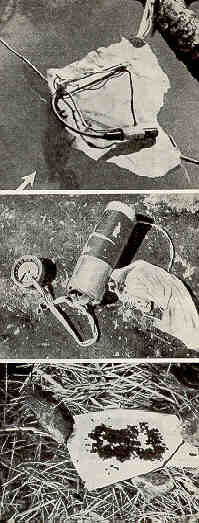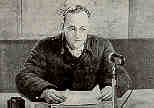



Of Bugs and Bombs
Introductory note by Kenn Thomas
Rumors have it that the movie version of X Files may have something to do with specially bred bees used to deliver a deadly viral plague. In part to forestall the routine trivialization and distortion of important historical realities which often accompany that show, Steamshovel Press offers a real life look at the possibility of insect-borne viruses. It comes from Colonel Frank H. Schwable, a US pilot captured by the Koreans during the Korean War who confessed to his role in a bacteriological warfare project that utilized populations of germ-infested flies and mosquitos dropped on the enemy in bombs, replete with miniature parachutes. The story has another angle, however. It might have been coerced from Schwable under Korean brainwashing torture. Other airman captured during the Korean War claimed that similar "confessions" were forced from them. After Korean complaints over the germ bug bombs, promised investigations by the International Red Cross and the World Health Organization never materialized. A 1952 scientific commission, which had as a member a witness to WWII Japanese germ warfare who spoke fluent Chinese, concluded that the charges were true. A preliminary investigation of Schwable after the war went nowhere. Secret post- WWII deals between the US and the infamous Shiro Ishii's Unit 731, the germ warfare program of imperial Japan, are documented by Jonathan Vankin in in Steamshovel Press #9. Authors Jon Holliday and Bruce Cummings note in their history, Korea The Unknown War (Pantheon, 1988) that "The argument that probably carried the most weight [that Schwabel's charges were false] was that the USA could not have used a weapon as horrible as germ warfare, though nothing can be established by this assertion. The USA was engaged in germ-warfare research. It has employed Japanese and Nazi germ-warfare experts and was at the time rushing through work on the nerve gas Sarin, a chemical weapon that was banned by the Geneva convention. The evidence shows preparations for using germ warfare (which do not prove anything about whether it was used or not.)" Sarin gas, of course, is chemical weapon of choice for the Aum Shinrokyo sect. Interestingly, after the Korean War US church groups began the Heifer Project, a program to rebuild the Korean insect population lost to the widespread use of DDT. It shipped over planeloads of honey bees.U.S. Wages Germ Warfare in Korea Statement of Prisoner of War, Colonel Frank H. Schwable
-------------------------------Hsinhua photo

Colonel Frank H. Schwable, 04429, former Chief of Staff of the United States First Marine Aircraft Wing, broadcasting in North Korea in February, 1953, the full details of the strategic plan and bacteriological warfare operations of American aircraft in Korea
The [North Korean] Hsinhua Agency has made public the following full text of the signed deposition made by Colonel Frank H. Schwable, Chief of staff of the U.S. First Marine Aircraft Wing, disclosing the strategic plan and aims of the American Command in waging germ warfare in Korea. I am Colonel Frank H. Schwable, 04429, and was Chief of Staff of the First Marine Aircraft Wing until shot down and captured on July 8, 1952. My service with the Marine Corps began in 1929 and I was designated an aviator in 1931, seeing duty in many parts of the world. Just before I came to Korea, I completed a tour of duty in the Division of Aviation at Marine Corps Headquarters. DIRECTIVE OF THE JOINT CHIEFS OF STAFF I arrived in Korea on April 10, 1952, to take over my duties as Chief of Staff of the First Marine Air- craft Wing. All my instructions and decisions were subject to confirmation by the Assistant Commanding General, Lamson-Scribner. Just before I assumed full responsibility for the duties of Chief of Staff, General Lamson-Scribner called me into his office to talk over various problems of the Wing. During this conversa- tion he said: "Has Binney given you all the background on the special missions run by VMF-513?" I asked him if he meant "suprop" (our code name for bac- teriological bombs) and he confirmed this. I told him I had been given all the background by Colonel Binney. Colonel Arthur A. Binney, the officer I relieved as Chief of Staff, had given me, as his duties required that he should, an outline of the general plan of bac- teriological warfare in Korea and the details of the part played up to that time by the First Marine Air- craft Wing. The general plan for bacteriological warfare in Korea was directed by the United States Joint Chiefs of Staff in October, 1951. In that month the Joint Chiefs of Staff sent a directive by hand to the Com- manding General, Far East Command (at that time General Ridgway), directing the initiation of bac- teriological warfare in Korea on an initially small, experimental stage but in expanding proportions. This directive was passed to the Commanding Gen- eral, Far East Air Force, General Weyland, in Tokyo. General Weyland then called into personal conference General Everest, Commanding General of the Fifth Air Force in Korea, and also the Commander of the Nineteenth Bomb Wing at Okinawa, which unit operates directly under FEAF. The plan that I shall now outline was gone over, the broad aspects of the problem were agreed upon and the following information was brought back to Korea by General Everest, personally and verbally, since for security purposes it was decided not to have anything in writing on this matter in Korea and subject to pos- sible capture. OBJECTIVES The basic objective was at that time to test, under field conditions, the various elements of bacteriological warfare, and to possibly expand the field tests, at a later date, into an element of the regular combat operations, depending on the results obtained and the situation in Korea. The effectiveness of the different diseases available was to be tested, especially for their spreading or epidemic qualities under various circumstances, and to test whether each disease caused a serious disrup- tion to enemy operations arid civilian routine or just minor inconveniences, or was contained completely, causing no difficulties. Various types of armament or containers were to be tried out under field conditions and various types of aircraft were to be used to test their suitability as bacteriological bomb vehicles. Terrain types to be tested included high areas, seacoast areas, open spaces, areas enclosed by moun- tains, isolated areas, areas relatively adjacent to one another, large and small towns and cities, congested it's and those relatively spread out. These tests were to be extended over an unstated period of time but sufficient to cover all extremes of temperature found in Korea. All possible methods of delivery were to be tested as well as tactics developed to include initially night attack and then expanding into day attack by special- ized Squadrons Various types of bombing were to be tried out, and various combinations of bombing, from single planes up to and including formations of planes, were to be tried out, with bacteriological bombs used in conjunction with conventional bombs. Enemy reac- tions were particularly to be tested or - observed by any means available to ascertain what his counter- measures would be, what propaganda steps he would take, and to what extent his military operations would be affected by this type of warfare. Security measures were to be thoroughly tested- both friendly and enemy. On the friendly ride, all pos- sible steps were to be taken to confine knowledge of the use of this weapon and to control information on the subject. On the enemy side, every possible means was to be used to deceive the enemy and prevent his actual proof that the weapon was being used. Finally, if the situation warranted, while continuing the experimental phase of bacteriological warfare according to the Joint Chiefs of Staff directive, it might be expanded to become a part of the military or tac- tical effort in Korea. INITIAL STAGE The B-29s from Okinawa began using bacteriolog- ical bombs in November, 1951, covering targets all over North Korea in what might be called random bombing. One night the target might be in Northeast Korea and the next night in Northwest Korea. Their bacteriological bomb operations were conducted in combination with normal night armed reconnaissance as a measure of economy and security. Early in January 1952, General Schilt, then Com- manding General of the First Marine Aircraft Wing, was called to Fifth Air Force Headquarters in Seoul, where General Everest told him of the directive issued by the Joint Chiefs of Staff, and ordered him to have VMF-513-Marine Night Fighter Squadron 513 of Marine Aircraft Group 33 of the First Marine Air- craft Wing-participate in the bacteriological war- fare program. VMF-513 was based on K8, the Air Force base at Kunsan of the Third Bomb Wing, whose B-26s had already begun bacteriological operations. VMF-513 was to be serviced by the Third Bomb Wing. While all marine aircraft (combat types) shore based in Korea operate directly under the Fifth Air Force, with the First Marine Aircraft Wing being kept in- formed of their activities, when a new or continuing program is being initiated, the Fifth Air Force normally has initially informed the Wing as a matter of cour- tesy. Towards the end of January 1952, Marine night fighters of Squadron 513, operating as single planes on night armed reconnaissance, and carrying bacteriological bombs, shared targets with the B-26s covering the lower half of North Korea with the greatest emphasis on the western portion. Squadron 513 coordinated with the Third Bomb Wing on all these missions, using F7F aircraft (Tiger Cats) because of their twin engine safety. K8 (Kunsan) offered the advantage of take-off directly over the water, in the event of engine failure, and both the safety and security of over-water flights to enemy territory. For security reasons, no information on the types of bacteria being used was given to the First Marine Aircraft Wing. In March 1952, General Schilt was again called to Fifth Air Force Headquarters and verbally directed by General Everest to prepare Marine Photographic Squadron I (VMJ-1 Squadron) of Marine Aircraft Group 33, to enter the program. VMJ-1 based on K3, Marine Aircraft Group 33's base at Pohang, Korea, was to use F2H-2P photographic reconnaissance aircraft (Banshees). The missions would be intermittent and combined with normal photographic missions and would be scheduled by the Fifth Air Force in separate, top-secret orders. The Banshees were brought into the program because of their specialized operations, equipment, facilities and isolated area of operations at K3. They could penetrate further into North Korea as far as enemy counteraction is concerned and worked in two-plane sections involving a minimum of crews and disturb- ance of normal missions. They could also try out bombing from high altitudes in horizontal flight in conjunction with photographic runs. During March 1952, the Banshees of Marine Photo- graphic Squadron 1 commenced bacteriological opera- tions, continuing and expanding the bacteriological bombing of North Korean towns, always combining these operations with normal photographic missions. Only a minimum of bomb supplies were kept on hand to reduce storage problems, and the Fifth Air Force sent a team of two officers and several men to Y\3 (Pohang) to instruct the marine specialists in handling the bombs. The Navy's part in the program was with the F9Fs (Panthers), ADs (Skyraiders) and standard F2Hs (Banshees), which as distinct from the photographi-- configuration, used carriers off the east coast of Korea. The Air Force had also expanded its own operations to include squadrons of different type aircraft, with different methods and tactics of employing bacterio- logical warfare. This was the situation up to my arrival in Korea. Subsequent thereto, the following main events took place. --cont'd--